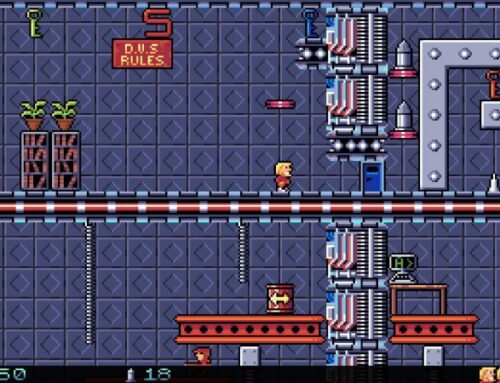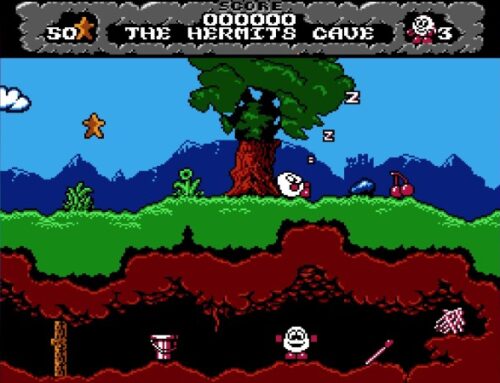Flight sims were once a big deal in the world of PC gaming. To a certain extent they still are, but today the field is mostly dominated by pretty hardcore civil aviation simulators such as Microsoft Flight Simulator and X-Plane. Back in the day, MicroProse recognised the market for more “casual-friendly” sims — and from that philosophy we got Dogfight: 80 Years of Aerial Warfare, originally released in 1993 for MS-DOS PC, Amiga and Atari ST, and subsequently rereleased on Steam as part of the partnership between nu-MicroProse and whatever Atari has decided they are this week.
Dogfight’s casual-friendly fun isn’t without precedent, either, even though MicroProse had developed a reputation for solid, realistic sims. Many of the company’s earlier efforts at flight simulators erred a little more on the arcadey side of things, dating right back to Sid Meier’s classic F-15 Strike Eagle and the split-screen two-player MiG Alley Ace.

Naturally, of course, Dogfight’s de-emphasis of the “simulation” aspect in favour of providing something fun and accessible caused some players to turn their nose up at it — particularly as they believed that there were plenty of other sims under the MicroProse banner that proved just as accessible on their lower difficulty levels. But Dogfight still has its appeal, and with it only costing a fiver now, it’s easy enough to explore that.
The concept behind Dogfight, as its full name suggests, is a celebration of the history of war in the skies, from World War I biplanes up to then-modern jet fighters such as the F-16 Fighting Falcon. In total, there are twelve different aircraft to fly — two each for six different “eras” represented in the game — with each having their own distinctive characteristics and considerations.
There are three main ways to play Dogfight. Firstly, you can simply jump into an immediate instant-action dogfight using any of the planes in the game and choosing your starting position relative to your enemy. If you’ve ever played Warbirds on the Atari Lynx, this is essentially exactly what that game offered, only with more aircraft to fly. If you just fancy shooting a plane down, this is for you — but long term it’s perhaps best used simply to get accustomed to the basics of each plane.

One of Dogfight’s main attractions is its “What If?” mode, which allows you simple free flight in any of the aircraft, a custom matchup against a computer opponent (pitting any of the twelve aircraft against one another) or a multiplayer game over a serial connection. The latter option is likely a bit of a pain to set up these days on modern machines, but if you have the opportunity to do so with a proper retro machine, there are good times to be had.
The main event, such as it is, is the Missions mode. Here, each aircraft has its own mission for you to accomplish, which generally consists of several different objectives including both air-to-air and air-to-ground tasks. Before you start a mission, you’re able to allocate a limited number of resources to plan out the overall mission, meaning that you can assign additional wings of fighters to escort you, blow up targets you can’t be bothered to fly to or simply frighten the residents of Brighton in the midst of the Battle of Britain.
In practice, this is a nice idea, but there’s not a lot of depth to it. Assigning resources appropriately comes into its own on the higher difficulty levels, particularly as your own plane’s armament is realistically limited, but on the easier levels it’s perfectly possible to lone-wolf the entire mission yourself, making your allies feel a tad redundant. I suppose there’s something to be said for indulging power fantasies now and then, after all.

Once you’re actually into a mission — or playing any of the other modes — you’ll initially be presented with a heavily simplified cockpit view, prioritising your view through the canopy and your gunsight or head-up display more than anything else. Basic flight information — speed, altitude, heading and the load of your current weapon — is displayed in the top corner of the screen, and aside from that, there’s not a lot to look at other than the 1993-era polygonal scenery.
Things get a bit more interesting if you hit F2 to go “head-down” and look at your instrument panel, and you can also hit the “S” key in this mode to split the display between part of your instrument panel and the view through the canopy. In practical terms, though, the split view doesn’t display enough of your instruments to be really that useful, so you’ll likely want to spare a fair amount of time switching between views. Those who are familiar with a very old Mirrorsoft flight sim called Spitfire 40 will know what to expect.
In fact, switching between views is a key part of playing Dogfight, since all the planes — regardless of whether they’re modern craft with electronic systems — are a little sparse in terms of helping you navigate. You have access to a real-time mission map at any time by tapping F9, and from there you can select any of the allied or enemy forces on the field to assign as a target, but outside of a little “X” that appears at the edge of the screen when your target is not directly in front of you, you’re given very little indication of where your target or waypoint actually is.

This is realistic in terms of the earlier aircraft, of course, but it’s a tad annoying in the more modern aircraft — particularly as the F-16 in particular clearly has a multi-function display in its “heads-down” instrument panel view, but for one reason or another it does absolutely nothing! A simple mini-map would have been nice; earlier MicroProse sims provided this with no problem.
Instead, the best way to approach navigation in Dogfight is to assign yourself a target via the map screen, then use a combination of the “Tacti-View” and the polygonal “Heads-Up” cockpit view to orient yourself accordingly.
Tacti-View is an external view which MicroProse introduced in some of its earlier titles such as F-19 Stealth Fighter and F-15 Strike Eagle II, and it keeps your aircraft fixed on screen, but rotates the angle so that it’s always facing your target. Turn your aircraft so that it’s flying “into” the screen and you’re heading for your target. There’s also an Inverse Tacti-View, which allows you to see from the perspective of your target, always looking towards your plane. Neither are especially practical for actual combat, but they are handy for navigation at least.

The Heads-Up cockpit view, meanwhile, is similar to the “padlock view” found in some other flight sims of the era. Here, the bitmapped representation of the cockpit is replaced with a simple polygonal view which simulates the movement of your head, as if you were continuing to look directly at your target. Again, turn your craft so that you can see out of the front and you’ll be heading in the right direction. This view is a little more practical for use in combat.
Another interesting feature of Dogfight is actually a side-effect of the tech of the time. Since the game runs at 320×200 VGA resolution — very large pixels by today’s standards, Dogfight deliberately makes targets “visible” in the distance quite early on, simply by representing them as a single coloured pixel.
Once you’re within this “visual” range, you’ll no longer need to rely on the different views; simply follow the pixel and approach it until it becomes something recognisable, at which point you’ll likely be in weapons range. While this “feature” may be born from limited technology, it actually works rather well, and definitely makes up for the more primitive aircraft lacking radar.

Depending on your aircraft, you’ll need to take out your target with either cannons or missiles. In both cases, successful destruction of your target rewards you with some satisfying (circular!) polygonal smoke rising from the wreckage, and the clear understanding that you’ve done a good job. In most cases, you don’t even need to fly back to base to complete the mission; just hit Escape on the keyboard for medals and rewards.
Alternatively, if you’re shot down or crash — and take note that rolling off the end of a runway, even at low speed, will cause you to immediately explode — your pilot will be killed, and in traditional MicroProse flight simulator tradition, you will no longer be able to use them. Since your pilot record keeps track of successful missions and medals earned, this adds a fun element of risk to the game — though the unscrupulous can, of course, find ways to circumvent the “permadeath” mechanic with manipulation of the game files. You won’t catch us doing that, though.
Ultimately, Dogfight mostly achieves what it sets out to do, which is to provide a simplistic, straightforward casual flight sim for those who just want to fly and shoot things. The flight model is highly unrealistic — though pleasingly varied between the different aircraft — and the selection of missions is very limited, but for when you just fancy a quick bit of aerial action it’s a worthwhile game to have in your collection.

And if you can nab a copy of the original boxed release, the glossy manual included makes for interesting reading, too, with plenty of historical and technical info about the available aircraft. There’s a PDF included with the digital release, but it’s just not the same.
One factor worth noting about this modern rerelease is that MicroProse has tuned the DOSBOX settings of the Steam release to simulate playing the game on a not-very-good 386. You’ll want to open up the dosbox.conf file in the game’s folder and edit it so that cputype=486_slow and cycles=20000 to get it running at a decent speed — don’t go too high on cycles, as the game’s physics can behave a little strangely if the frame rate is too high!
Anyway, if Dogfight sounds like it might be of interest, it’s worth having a play with. It’s by no means MicroProse’s finest piece of work, but it is an interesting curiosity worth fiddling around with for a bit — and a game that I feel could probably benefit from a modern makeover! That’s a discussion for a whole other day, though…




